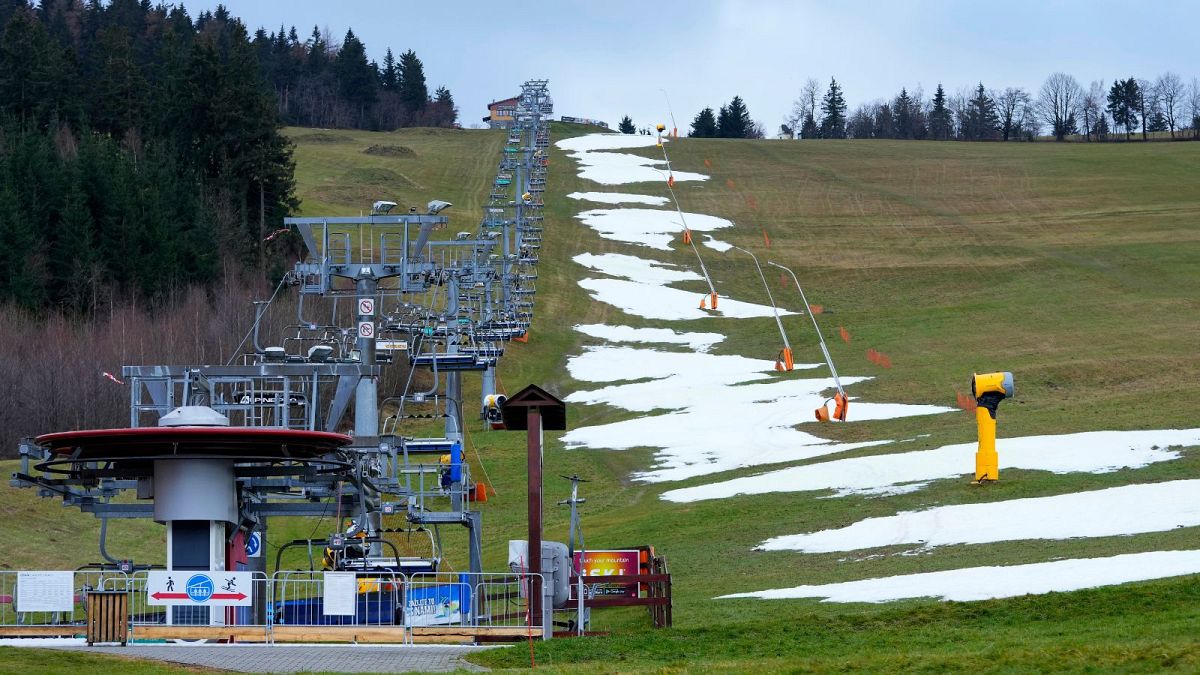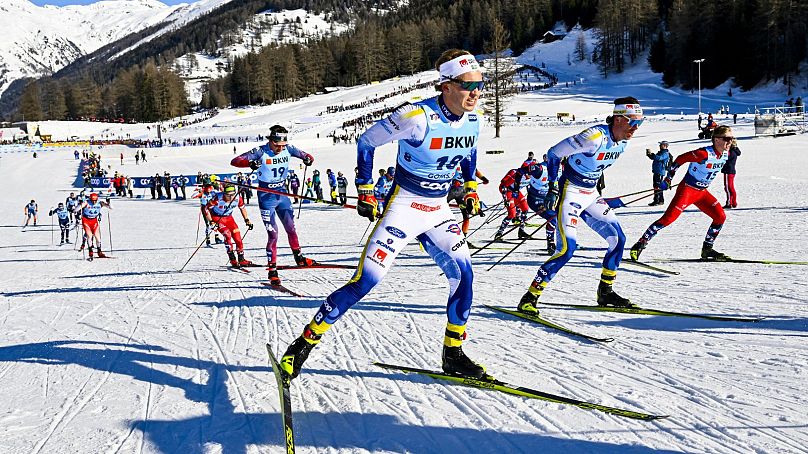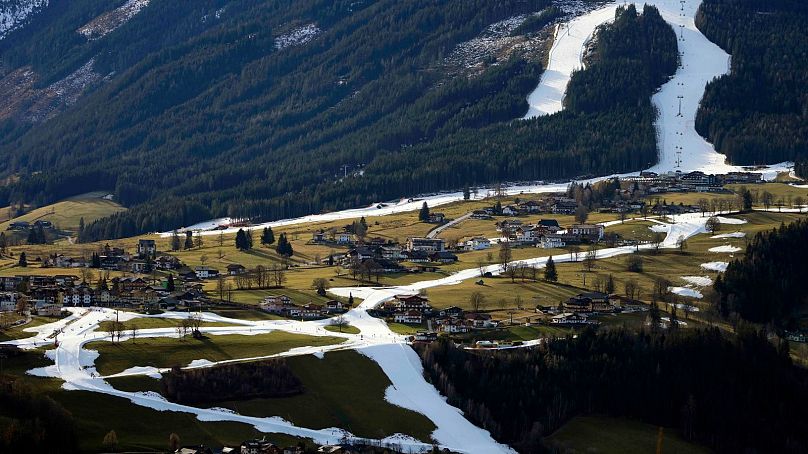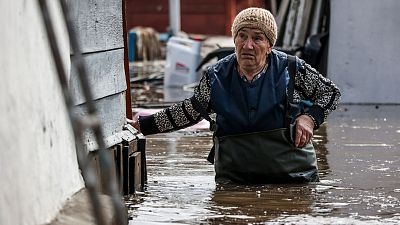Campaigners are calling on winter sports organisers to drop polluting sponsors as European ski slopes suffer the consequences.
Winter sports sponsors including Audi and Equinor will melt almost 2,000 square kilometres worth of snow a year with their carbon emissions, according to a new report.
For the first time, campaigners have formulated a way to measure the climate impact of major sponsorship deals with polluting industries.
The findings from the New Weather Institute think tank underline an already glaring irony: winter sports are imperilled by many of their largest backers.
“Winter athletes want to solely focus on their performance but the spectre of climate change looms large over every single snow sport,” says Anna Turney, former British alpine skier and Paralympian.
Record temperatures across Europe have forced the cancellation of numerous alpine and cross-country ski races this 2023-24 season due to poor snow cover, as well as closing many ski resorts.
“Snow sports organisations need to show courage and be brave,” adds Turney. “If we do not change, then there will be no more snow sports.”
The ‘Dirty Snow’ report from New Weather Sweden and its Badvertising campaign is released today as the International Ski & Snowboard Federation (FIS) Ski World Cup kicks off in Austria.
How can we calculate the snow melt from a sponsorship deal?
Car maker Audi is the main sponsor of the Ski World Cup which runs from 16-24 March on the slopes of Salzburg.
The multi-million euro deal will generate between 103,000 - 144,000 tonnes CO2e (carbon dioxide equivalent emissions) according to the campaigners. The climate impact is comparable to between 238,000 and 333,000 barrels of oil.
This estimate was reached using a first-of-its-kind formula for calculating the emissions created for every euro spent on a high-carbon sponsorship.
As shown in the report, the equation factors in figures including a company’s yearly CO2e and its gross revenue. It assumes the recipient accepts the “logical consequences” of helping to promote the polluter in question.
Using a calculation for the known relationship between emissions and snow cover loss, the report then calculates the impact of seven winter sports sponsors: Audi, Ford, SAS, Equinor, Aker, Volvo and Preem.
Altogether, the CO2 emissions of these polluting companies would melt an area of 1,968 square kilometres of spring snow each year.
That’s equal to a land surface area 195 times bigger than the skiing area of Skicircus Saalbach, one of the world’s largest skiing areas where the FIS Alpine World Cup Finals 2024 are being held. And 437 times bigger than the skiing area of Åre, Sweden’s largest ski resort and potential bidder for the 2030 Olympics.
How are European winter sports and ski resorts impacted by climate change?
Europe’s ski slopes are already seriously afflicted by climate change. By late February, nine of the planned Alpine Ski World Cup races of the season were cancelled due to poor snow cover.
The outlook is bleak: winters in mid-latitudes in the Northern Hemisphere are expected to shrink by 4.7 days per decade under current trends. In a high-emission scenario, winter could shrink to a single month by the end of the century (from 18 December to 18 January).
And it’s not just athletes who are missing out, as European ski resorts are forced to transition to summer activities in March.
Others are resorting to artificial snow: approximately 25 per cent of skiing areas in Germany, 39 per cent in France, 54 per cent in Switzerland, 70 per cent in Austria and a whopping 90 per cent of ski areas in Italy.
But as New Weather points out, producing artificial snow is an energy-intensive endeavour that further increases emissions.
Athletes and campaigners call for winter sports to cut ties with polluting companies
The bigger picture is that European snow sports are effectively doomed without deep and immediate emissions cuts. Campaigners argue that sports have a responsibility and role to play in realising this brighter future.
“It is a big irony that polluting sponsors within winter sports are melting the ice and snow that the sports are dependent upon,” says Anna Jonsson, co-director of New Weather Sweden. “To secure a future for winter sports, all organisers and athletes must drop polluting sponsors.”
“Every dollar or euro of sponsorship from major polluters is like a blowtorch turned on the future of winter sports,” adds Andrew Simms, New Weather Institute’s director. “They’re using sport as a billboard to sell more high carbon products that are killing our winters and now, for the first time, we can put a figure on the damage their money does.”
Climate-conscious winter sports stars are taking a stand too. “There is a clear role here for elite athletes to speak up and sound the alarm, as important influencers in society,” says former Dutch elite skater Mark Ooijevaar.
"Many sports federations and professional athletes are marketing an idealised, elite lifestyle with high consumption of products and travel,” observes Björn Sandström, Swedish elite cross country skier, environmental scientist and consultant in climate calculations.
“This sends a message to younger generations leading to more people striving towards this 'glamorous life'. But the research is clear - we have to leave these unsustainable behaviours that are leading us deeper into the climate crisis.”
Report follows successful climate campaigns in tennis and rugby
Sporting events, teams and individual athletes are coming under increasing pressure for partnering with polluting companies amid the climate crisis.
Fossil fuel giant TotalEnergies, for example, was targeted by African campaigners for its sponsorship of the African Cup of Nations (AFCON) football tournament. And climate activists have disrupted a number of events, from the US Open to the World Snooker Championship.
At times, these demands have been heard. New Weather notes that several sports organisations have ended commercial partnerships with polluting companies.
The Australian Open ended its sponsorship deal with oil and gas giant Santos after a grassroots campaign, while the English Rugby Football Union (RFU) turned down a commercial sponsorship deal with US fossil fuel major ExxonMobil.
To increase the transparency around such deals, New Weather is calling for sports organisers to disclose the value of polluting sponsorships. And it wants “companies that are major drivers of climate change” - like oil and gas firms, car manufacturers and airlines - to exit the sporting arena entirely.
“As a former member of the Swedish national ski team, I wish that ski associations and races would stop promoting companies that melt our sport away,” says Emil Johansson Kringstad, a former Swedish elite cross country skier.





